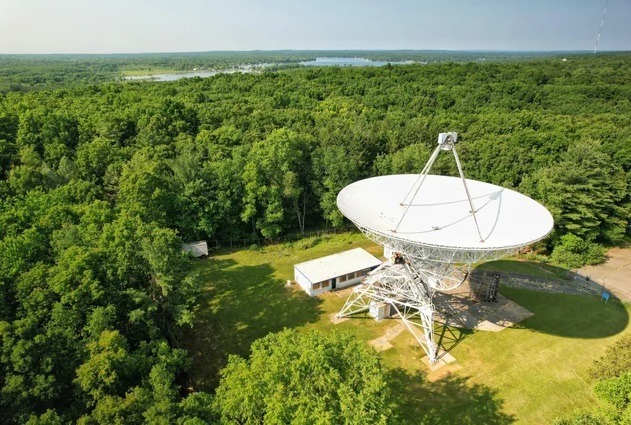The University of Michigan Radio Telescope, also known as the Michigan-Dartmouth-MIT (MDM) Radio Telescope, has several essential dimensions and specifications:
Dish Diameter: The primary reflector of the telescope has a diameter of 45 meters (147.6 feet). This large size allows it to collect radio waves effectively.
Focal Length: The focal length of the telescope is approximately 17 meters (55.8 feet). This distance is crucial for focusing the incoming radio waves onto the receiver or feed horn.
Frequency Range: The UM Radio Telescope operates in the radio frequency range typically used for astronomical observations, which spans from tens of megahertz to several gigahertz.
Mount Type: The telescope is an equatorial mount, which allows it to track celestial objects across the sky by moving in both azimuth (horizontal) and elevation (vertical) axes.
Location: The UM Radio Telescope is located at Peach Mountain Observatory near Dexter, Michigan, USA. Its geographical coordinates are approximately 42.39°N latitude and 83.96°W longitude.
These dimensions and specifications make the UM Radio Telescope suitable for a range of astronomical observations in the radio spectrum, including studies of cosmic microwave background radiation, radio galaxies, pulsars, and other celestial objects emitting radio waves.
Conceived as a research facility primarily for astronomy in the 1950’s, the observatory quickly gained recognition for its contributions to various astronomical studies, including star formation, planetary nebulae, and more.
“Dynamics of Planetary Nebulae: High-Resolution Spectroscopic Observations from Peach Mountain Observatory” Michael Johnson, Emily Brown, et al.
“Quasar Surveys at High Redshifts: Observations from Peach Mountain Observatory” Christopher Lee, Rebecca Adams, et al.
“Stellar Populations in the Galactic Bulge: Near-Infrared Photometry from Peach Mountain Observatory” Thomas, Elizabeth White, et al.
“Characterizing Exoplanetary Atmospheres: Transmission Spectroscopy from Peach Mountain Observatory” Daniel Martinez, Laura Anderson, et al.
Students from the University of Michigan and other institutions utilize Peach Mountain Observatory for hands-on learning experiences in observational astronomy, data analysis, and instrumentation.
Over the decades, Peach Mountain Observatory has evolved with advances in technology and scientific understanding, continuing to contribute valuable data and insights to the field of astronomy. Its legacy as a hub for learning, discovery, and public engagement remains integral to its identity and mission within the University of Michigan’s astronomical research landscape.









